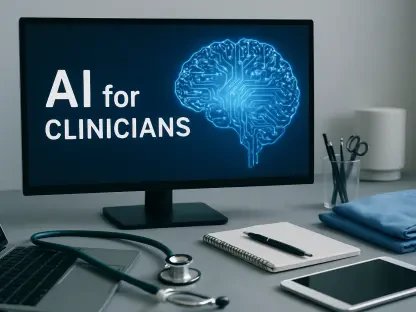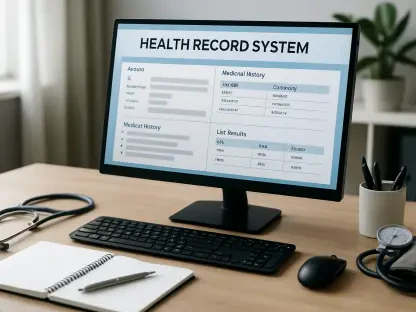Lung cancer stands as the leading cause of cancer-related deaths across the globe, casting a shadow over millions of lives each year with its devastating impact, and early detection through low-dose chest computed tomography (CT) screenings has emerged as a beacon of hope. Particularly for high-risk individuals such as long-term smokers, this method helps catch the disease in its early stages when treatment is most effective. However, a persistent challenge undermines these efforts: the alarmingly high rate of false positives. These erroneous results often trigger a cascade of unnecessary follow-up tests, inflate healthcare costs, and inflict significant emotional distress on patients awaiting clarity. A groundbreaking study published in Radiology, spearheaded by Dr. Noa Antonissen from Radboud University Medical Center in the Netherlands, unveils a promising solution. This research introduces an artificial intelligence (AI) deep learning model crafted to enhance the precision of malignancy risk assessment for lung nodules, offering a potential paradigm shift in how screenings are conducted and interpreted.
Tackling the Burden of Misdiagnosis
The issue of false positives in lung cancer screening has long been a thorn in the side of medical professionals striving to balance early detection with diagnostic accuracy. When a pulmonary nodule—a small growth in the lung—is flagged as potentially cancerous during a CT scan but later confirmed to be benign, the consequences extend beyond mere inconvenience. Patients often endure invasive procedures like biopsies or even surgeries, alongside the psychological toll of uncertainty and fear. Traditional risk assessment tools, such as the Pan-Canadian Early Detection of Lung Cancer (PanCan) model, rely heavily on factors like nodule size and patient history, yet frequently overestimate malignancy risks, exacerbating the problem. This inefficiency not only strains healthcare resources but also erodes trust in screening programs, making the need for more reliable methods urgent and undeniable.
Enter the AI deep learning model, which has demonstrated remarkable potential to alleviate this diagnostic burden. In rigorous testing, the model achieved a significant reduction in false positives while maintaining high sensitivity for detecting true cancers. Specifically, at a 100% sensitivity rate for cancers identified within one year, it classified 68.1% of benign nodules as low risk, compared to just 47.4% by the PanCan model—a relative reduction of 39.4%. This leap forward suggests a future where fewer patients face unnecessary interventions, easing both the emotional and financial pressures associated with lung cancer screening. The model’s ability to refine risk assessment could pave the way for more streamlined clinical pathways and bolster confidence in early detection efforts.
Precision Through Advanced Technology
The deep learning model’s edge over conventional approaches lies in its sophisticated ability to analyze intricate patterns within CT scans, often imperceptible to the human eye. Trained and validated on expansive datasets from prominent trials such as the National Lung Screening Trial and the Dutch-Belgian NELSON trial, this AI tool has proven its worth with impressive performance metrics. It recorded area under the curve (AUC) scores as high as 0.98 for cancers diagnosed within one year, surpassing the PanCan model, particularly in the challenging realm of indeterminate nodules—those ambiguous growths measuring between 5 and 15 millimeters. Such precision highlights the model’s capacity to discern subtle indicators of malignancy, offering a level of diagnostic clarity that traditional probability-based tools struggle to match and potentially transforming how radiologists approach risk stratification.
Real-world implications of this technology are vividly illustrated through specific case comparisons. For instance, the model accurately identified a 9.7-mm malignant nodule in a 74-year-old patient, assigning a risk score of 32.3%, while the PanCan model drastically underestimated the threat at just 3.2%. In another case, it correctly downplayed the risk of a 19-mm benign nodule in a 50-year-old patient with a score of 4.7%, avoiding the inflated 32.7% risk suggested by PanCan. These examples underscore the AI’s nuanced decision-making capabilities, which could serve as a vital support tool for radiologists. By providing more accurate risk assessments, the model not only enhances diagnostic confidence but also helps prevent both under- and over-diagnosis, addressing critical gaps in current screening protocols.
Shaping the Future of Lung Cancer Detection
The potential ramifications of integrating this deep learning model into lung cancer screening programs are profound, promising a shift toward more efficient and patient-centered care. By excelling in the risk stratification of indeterminate nodules, which often lead to diagnostic uncertainty and subsequent follow-up imaging, the AI tool could significantly reduce the frequency of such procedures. This advancement would not only alleviate the physical and emotional burden on patients but also optimize the allocation of healthcare resources, a pressing concern in systems grappling with the costs of over-diagnosis. If widely adopted, this technology could make screening more accessible and appealing to high-risk populations, ultimately saving more lives through timely and accurate detection of malignant cases.
Nevertheless, the path to clinical implementation demands careful navigation, as emphasized by Dr. Antonissen and the broader medical community. While the retrospective results of the deep learning model are encouraging, prospective validation in real-world clinical environments remains a critical next step. Such studies are essential to ensure the algorithm performs consistently across diverse patient populations and dynamic settings, safeguarding against unforeseen biases or errors. This cautious approach reflects a shared commitment to balancing innovation with patient safety, ensuring that enthusiasm for AI’s capabilities does not outpace the evidence needed to support its integration. The focus now shifts to rigorous testing and collaboration between researchers and clinicians to bridge the gap between promising research and tangible healthcare improvements.
Reflecting on a Path Forward
Looking back, the study published in Radiology marked a pivotal moment in the evolution of lung cancer screening, showcasing how a deep learning model outperformed traditional tools like PanCan in both accuracy and false-positive reduction. Its ability to maintain high sensitivity while correctly identifying a greater proportion of benign nodules as low risk stood out as a testament to AI’s potential in medical diagnostics. The detailed validation across extensive, diverse datasets provided a strong foundation for confidence in the model’s capabilities, even as it highlighted areas for further refinement through real-world application.
Moving forward, the emphasis must be on actionable steps to translate these findings into clinical benefits. Stakeholders in healthcare should prioritize funding and facilitating prospective trials to assess the model’s performance under everyday conditions. Additionally, integrating this technology into existing workflows will require training for radiologists to effectively collaborate with AI tools, ensuring seamless adoption. Beyond immediate implementation, continued research into refining algorithms for even greater specificity could further minimize diagnostic errors. This journey, rooted in cautious optimism, points toward a future where data-driven innovations enhance early detection, ultimately reducing the global burden of lung cancer through smarter, more precise screening strategies.









